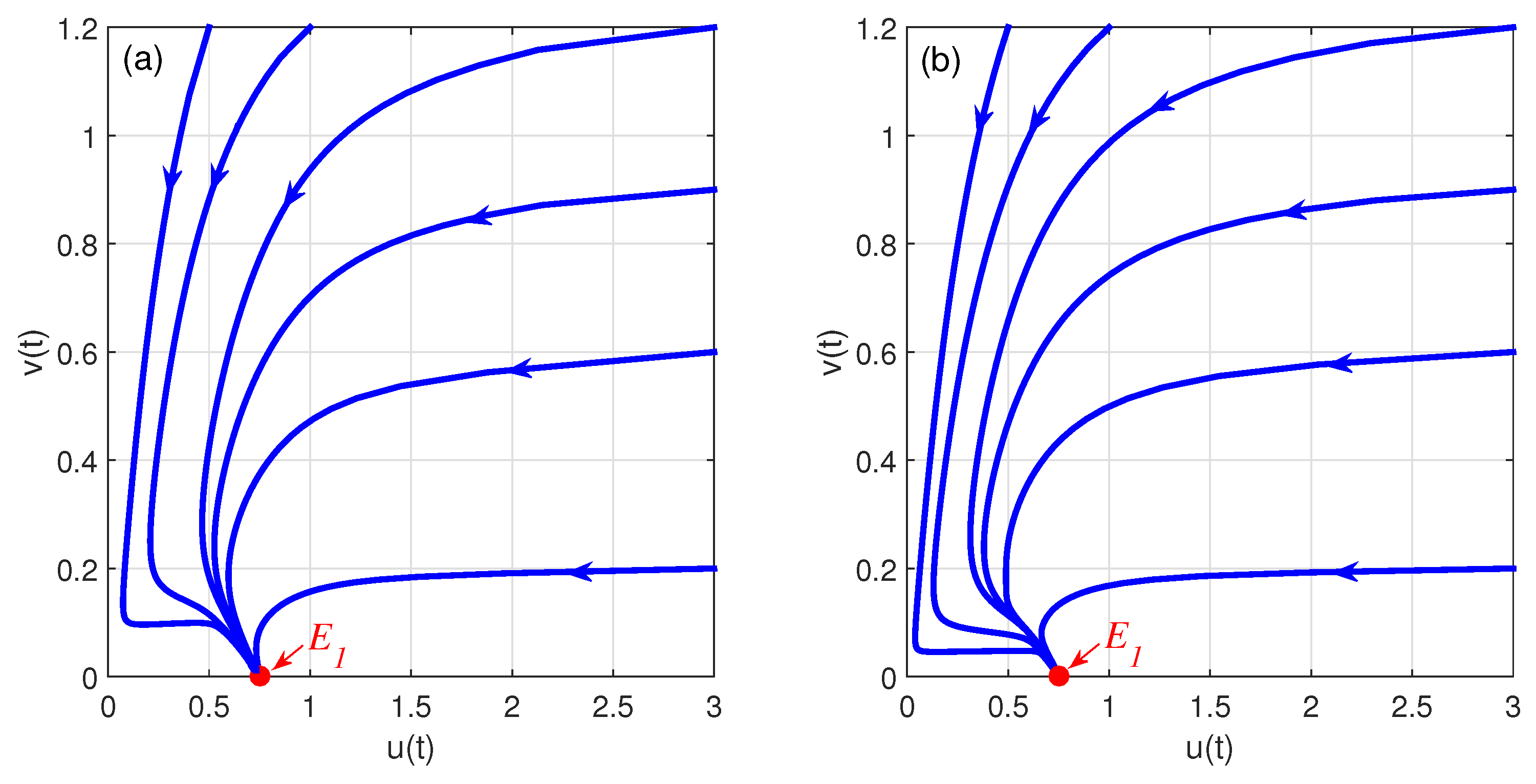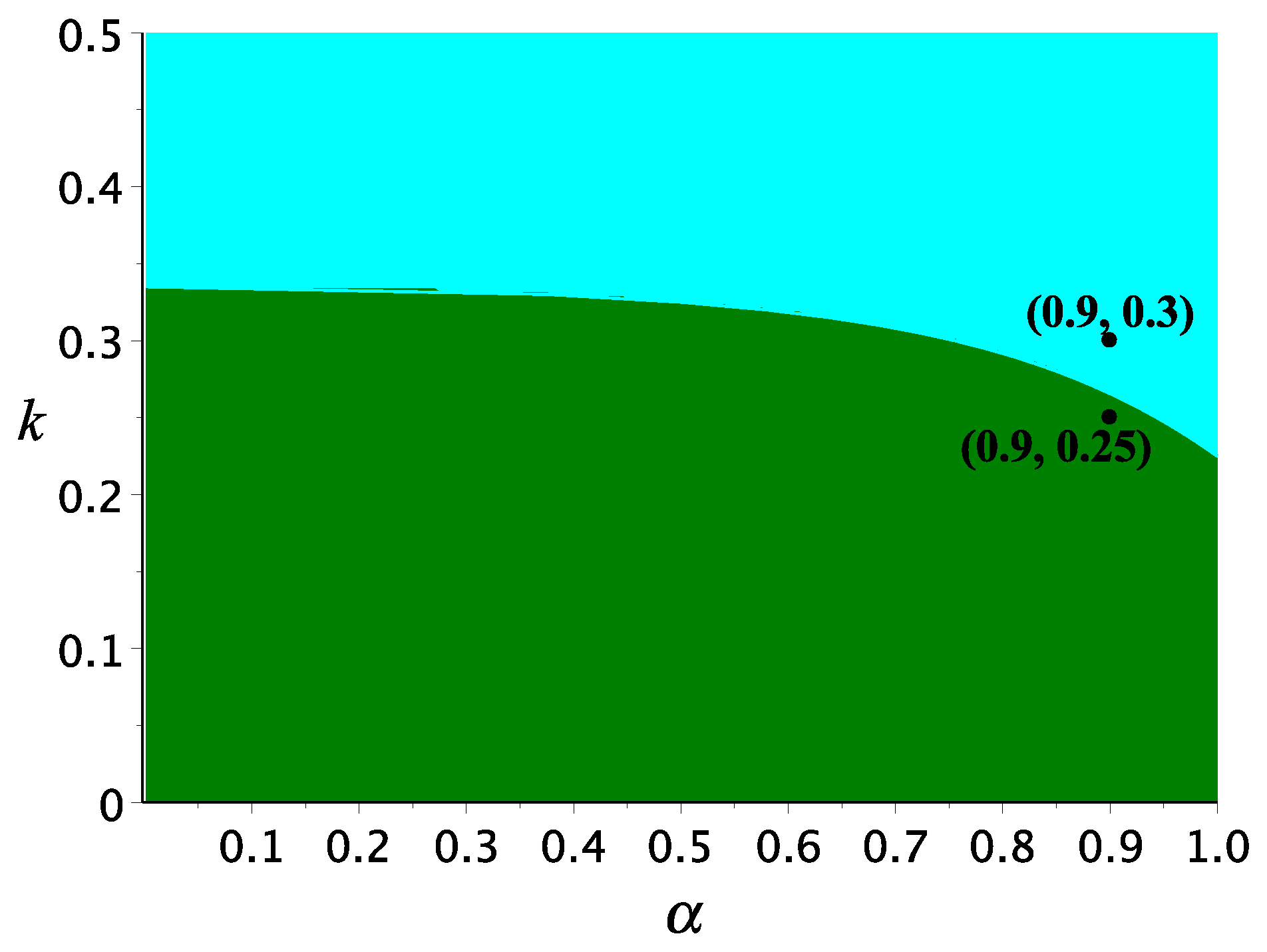A Fractional-Order Predator–Prey Model with Ratio-Dependent Functional Response and Linear Harvesting
Abstract
1. Introduction
2. Preliminaries
3. Main Results
3.1. Existence and Uniqueness
3.2. Boundedness and Non-Negativity
3.3. Local Stability
- The extinction point of both prey and predator population which is always feasible.
- The free predator point , which also always exists. Here, .
- The interior point where and . Notice that exists if .
- 1.
- is a saddle point.
- 2.
- If, thenis locally asymptotically stable and it is a saddle if.
- The Jacobian matrix in Equation (8) evaluated at isThe eigenvalues of are and , and consequently we have and for . Hence, is a saddle point.
- If is substituted into the Jacobian matrix in Equation (8), then we haveObviously, has eigenvalues and . We observe that . If , then and thus . On the other hand, if , then , and consequently . Therefore, is asymptotically stable (locally) if and is a saddle point if .
- 1.
- and
- 2.
- and.
- Since and , and . Therefore, is asymptotically stable.
- Suppose . If is an eigenvalue, then its complex conjugate is also an eigenvalue. We have that . Using the Matignon’s condition (see Theorem 2), it is obvious that is locally asymptotically stable if .
3.4. Hopf Bifurcation
- (i)
- The eigenvalues of the Jacobian matrix are a pair of complex-conjugate: ;
- (ii)
- ; and
- (iii)
3.5. Global Asymptotic Stability
4. Numerical Simulations
5. Concluding Remarks
Author Contributions
Funding
Conflicts of Interest
References
- Gause, G.; Smaragdova, N.; Witt, A. Further studies of interactions between predators and prey. J. Anim. Ecol. 1936, 5, 1–18. [Google Scholar] [CrossRef]
- Li, B.; Kuang, Y. Heteroclinic Bifurcation in the Michaelis–Menten-Type Ratio-Dependent Predator-Prey System. SIAM J. Appl. Math. 2007, 67, 1453–1464. [Google Scholar] [CrossRef]
- Rosenzweig, M.L.; MacArthur, R.H. Graphical Representation and Stability Conditions of Predator-Prey Interactions. Am. Nat. 1963, 97, 209–223. [Google Scholar] [CrossRef]
- Kuang, Y.; Beretta, E. Global qualitative analysis of a ratio-dependent predator-prey system. J. Math. Biol. 1998, 36, 389–406. [Google Scholar] [CrossRef]
- Hsu, S.B.; Hwang, T.W.; Kuang, Y. Global analysis of the Michaelis-Menten-type ratio-dependent predator-prey system. J. Math. Biol. 2001, 42, 489–506. [Google Scholar] [CrossRef] [PubMed]
- Xiao, D.; Ruan, S. Global dynamics of a ratio-dependent predator-prey system. J. Math. Biol. 2001, 43, 268–290. [Google Scholar] [CrossRef] [PubMed]
- Xiao, M.; Cao, J. Hopf Bifurcation and Non-Hyperbolic Equilibrium in a Ratio-Dependent Predator-Prey Model with Linear Harvesting Rate: Analysis and Computation. Math. Comput. Model. 2009, 50, 360–379. [Google Scholar] [CrossRef]
- Podlubny, I. Fractional Differential Equations: An Introduction to Fractional Derivatives, Fractional Differential Equations, to Methods of Their Solution and Some of Their Applications; Academic Press: California, CA, USA, 1999. [Google Scholar]
- Hamdan, N.I.; Kılıçman, A. A fractional order SIR epidemic model for dengue transmission. Chaos Solitons Fractals 2018, 114, 55–62. [Google Scholar] [CrossRef]
- Hamdan, N.I.; Kılıçman, A. Analysis of the fractional order dengue transmission model: A case study in Malaysia. Adv. Differ. Equ. 2019, 2019, 3. [Google Scholar] [CrossRef]
- Moustafa, M.; Mohd, M.H.; Ismail, A.I.; Abdullah, F.A. Dynamical analysis of a fractional-order Rosenzweig–MacArthur model incorporating a prey refuge. Chaos Solitons Fractals 2018, 109, 1–13. [Google Scholar] [CrossRef]
- Moustafa, M.; Mohd, M.H.; Ismail, A.I.; Abdullah, F.A. Stage Structure and Refuge Effects in the Dynamical Analysis of a Fractional Order Rosenzweig-MacArthur Prey-Predator Model. Prog. Fract. Differ. Appl. 2019, 5, 49–64. [Google Scholar] [CrossRef]
- Suryanto, A.; Darti, I.; Anam, S. Stability Analysis of a Fractional Order Modified Leslie-Gower Model with Additive Allee Effect. Int. J. Math. Math. Sci. 2017, 2017, 8273430. [Google Scholar] [CrossRef]
- Shang, Y. A Lie algebra approach to susceptible-infected-susceptible epidemics. Electron. J. Differ. Equ. 2012, 2012, 1–7. [Google Scholar]
- Shang, Y. Lie algebra method for solving biological population model. J. Theor. Appl. Phys. 2013, 7, 67. [Google Scholar] [CrossRef]
- Shang, Y. Lie algebraic discussion for aflnity based information diffusion in social networks. Open Phys. 2017, 15, 83. [Google Scholar] [CrossRef]
- Gazizov, R.; Kasatkin, A. Construction of exact solutions for fractional order differential equations by the invariant subspace method. Comput. Math. Appl. 2013, 66, 576–584. [Google Scholar] [CrossRef]
- Alshamrani, M.; Zedan, H.; Abu-Nawas, M. Lie group method and fractional differential equations. J. Nonlinear Sci. Appl. 2017, 10, 4175–4180. [Google Scholar] [CrossRef]
- Marin, M. Baleanu, D.; Vlase, S. Effect of microtemperatures for micropolar thermoelastic bodies. Struct. Eng. Mech. 2017, 61, 381–387. [Google Scholar] [CrossRef]
- Suryanto, A.; Darti, I. Stability Analysis and Nonstandard Grünwald-Letnikov Scheme for a Fractional Order Predator-Prey Model with Ratio-Dependent Functional Response. AIP Conf. Proc. 2017, 1913, 020011. [Google Scholar] [CrossRef]
- Li, Y.; Chen, Y.Q.; Podlubny, I. Stability of Fractional-Order Nonlinear Dynamic Systems: Lyapunov Direct Method and Generalized Mittag-Leffler Stability. Comput. Math. Appl. 2010, 59, 1810–1821. [Google Scholar] [CrossRef]
- Odibat, Z.M.; Shawagfeh, N.T. Generalized Taylor’s formula. Appl. Math. Comput. 2007, 186, 286–293. [Google Scholar] [CrossRef]
- Li, H.L.; Zhang, L.; Hu, C.; Jiang, Y.L.; Teng, Z. Dynamical Analysis of a Fractional-Order Predator-Prey Model Incorporating a Prey Refuge. J. Appl. Math. Comput. 2017, 54, 435–449. [Google Scholar] [CrossRef]
- Saleh, W.; Kılıçman, A. Note on the Fractional Mittag-Leffler Functions by Applying the Modified Riemann-Liouville Derivatives. Bol. Soc. Parana. Mat. 2019. [Google Scholar] [CrossRef]
- Matignon, D. Stability results on fractional differential equations to control processing. In Proceedings of the 1996 IMACS Multiconference on Computational Engineering in Systems and Application Multiconference, Lille, France, 9–12 July 1996; Volume 2, pp. 963–968. [Google Scholar]
- Petras, I. Fractional-Order Nonlinear Systems: Modeling, Analysis and Simulation; Springer: Beijing, China, 2011. [Google Scholar]
- Vargas-De-León, C. Volterra-type Lyapunov functions for fractional-order epidemic systems. Commun. Nonlinear Sci. Numer. Simul. 2015, 24, 75–85. [Google Scholar] [CrossRef]
- Huo, J.; Zhao, H.; Zhu, L. The effect of vaccines on backward bifurcation in a fractional order HIV model. Nonlinear Anal. Real World Appl. 2015, 26, 289–305. [Google Scholar] [CrossRef]
- Choi, S.K.; Kang, B.; Koo, N. Stability for Caputo Fractional Differential Systems. Abstr. Appl. Anal. 2014, 2014, 631419. [Google Scholar] [CrossRef]
- Shang, Y. Vulnerability of networks: Fractional percolation on random graphs. Phys. Rev. E 2014, 89, 0128131-4. [Google Scholar] [CrossRef]
- Abdelouahab, M.S.; Hamri, N.E.; Wang, J. Hopf Bifurcation and Chaos in Fractional-Order Modified Hybrid Optical System. Nonlinear Dyn. 2012, 69, 275–284. [Google Scholar] [CrossRef]
- Diethelm, K.; Ford, N.J.; Freed, A.D. A predictor-corrector approach for the numerical solution of fractional differential equations. Nonlinear Dyn. 2002, 29, 3–22. [Google Scholar] [CrossRef]
- Caputo, M.; Fabrizio, M. On the notion of fractional derivative and applications to the hysteresis phenomena. Meccanica 2017, 52, 3043–3052. [Google Scholar] [CrossRef]
- Atangana, A.; Baleanu, D. New fractional derivatives with nonlocal and non-singular kernel: Theory and application to heat transfer model. Therm. Sci. 2016, 20, 763–769. [Google Scholar] [CrossRef]





© 2019 by the authors. Licensee MDPI, Basel, Switzerland. This article is an open access article distributed under the terms and conditions of the Creative Commons Attribution (CC BY) license (http://creativecommons.org/licenses/by/4.0/).
Share and Cite
Suryanto, A.; Darti, I.; S. Panigoro, H.; Kilicman, A. A Fractional-Order Predator–Prey Model with Ratio-Dependent Functional Response and Linear Harvesting. Mathematics 2019, 7, 1100. https://doi.org/10.3390/math7111100
Suryanto A, Darti I, S. Panigoro H, Kilicman A. A Fractional-Order Predator–Prey Model with Ratio-Dependent Functional Response and Linear Harvesting. Mathematics. 2019; 7(11):1100. https://doi.org/10.3390/math7111100
Chicago/Turabian StyleSuryanto, Agus, Isnani Darti, Hasan S. Panigoro, and Adem Kilicman. 2019. "A Fractional-Order Predator–Prey Model with Ratio-Dependent Functional Response and Linear Harvesting" Mathematics 7, no. 11: 1100. https://doi.org/10.3390/math7111100
APA StyleSuryanto, A., Darti, I., S. Panigoro, H., & Kilicman, A. (2019). A Fractional-Order Predator–Prey Model with Ratio-Dependent Functional Response and Linear Harvesting. Mathematics, 7(11), 1100. https://doi.org/10.3390/math7111100






